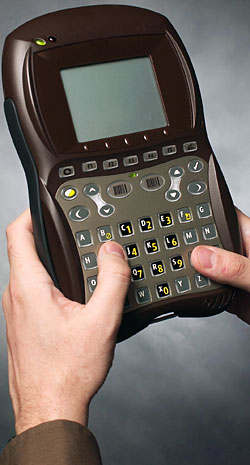
UPS is rolling out a new generation driver computer that can talk with four different wireless communication systems to speed tracking information to customers.
It's also smaller and lighter than its predecessor, works in color, is easier to use and has an expanded memory that will support some new, more customized services in the near future. Moreover, it is a critical part of a broader technology shift that is allowing UPS to dramatically reduce its fuel consumption while improving route planning, vehicle loading and package delivery.
"This is a key component of a bigger system that we call Package Flow Technology. Our drivers are going to have all the information in their handheld computers to make even more reliable deliveries while driving fewer miles," said Dave Barnes of UPS.
The new computer -- known as the fourth-generation Delivery Information Acquisition Device or DIAD IV -- will be deployed rapidly now that it has undergone more than a year of extensive field testing. Co-developed with Symbol Technologies, UPS expects to deploy 32,000 in the United States and 8,000 internationally by the end of this year. The company plans to have more than 70,000 in use worldwide by the end of 2007.
UPS was the first in its industry to equip drivers with a handheld computer, starting in 1991. Through each successive generation of the DIAD, UPS has accelerated the availability of customer tracking data as well as its ability to communicate with drivers. The latest version continues improvement in those and other areas.
The system provides links to the Global Positioning Satellite (GPS) system, which will improve customer service. GPS will give a dispatch center the ability to locate the most convenient driver to respond to an On-Call Pickup, for example. Eventually, the GPS link also will help drivers searching for an unfamiliar address and sound an alert if they're in the wrong driveway for a particular delivery.
The computer can connect real-time with four different wireless networks, including personal (Bluetooth); local (Wi-Fi), and wide area (GPRS or CDMA). The Bluetooth and Wi-Fi capabilities allow the DIAD to access printers and other devices within a UPS facility or with a customer's PC. CDMA is a wide-area wireless network standard used by UPS in the U.S. GPRS is another wide-area network standard used by UPS in the Americas, Europe and Asia.
A color screen accommodates color-coding of messages to drivers. Memory of 128 megabytes is 20 times that of DIAD III. UPS will use this expanded memory in the near future to provide new, more customized services to its customers.
"We always talk about this computer in terms of technical improvements, but we never lose sight of what it really means: a new tool for our drivers to offer reliable, one-to-one customer service by putting up-to-date information about each customer's delivery at the driver's fingertips," said Barnes.
"Over the past decade, the DIAD has been the critical customer-facing, front-end device of an integrated global network that's now tracking some 14.1 million deliveries every day. DIAD IV significantly expands the visibility surrounding those packages, and that's going to enable us to offer some nifty new services in the future."
UPS moves goods, information, and funds.